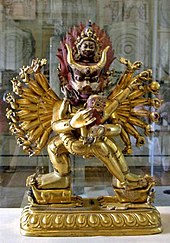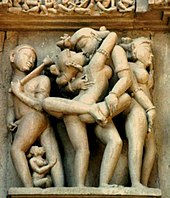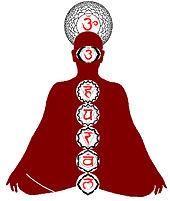Tantra
![]()
This article is about Tantra as a philosophy - for other meanings see Tantra (disambiguation).
![]()
This article or subsequent section is not sufficiently supported by evidence (e.g., anecdotal evidence). Information without sufficient evidence may be removed in the near future. Please help Wikipedia by researching the information and adding good supporting evidence.
This article is significantly lacking in supporting evidence, see discussion.
Tantra (Sanskrit तन्त्र, neuter, "tissue, continuum, connection") or Tantrism refers to various currents within Indian philosophy and religion that first emerged as an esoteric form of Hinduism and later Buddhism within the northern Mahayana tradition. The origins of Tantra begin in the 2nd century; in full form, teachings are available from the 7th/8th century at the earliest. In Buddhism it is also called Tantrayana ("vehicle of Tantra texts", compare Vajrayana). In almost all tantric schools and directions the worship and homage to the female deity is central; such worship already existed in ancient Vedic times (1750-1200 BC). Tantra combines sensuality with spirituality (compare also Neo-Tantra).

Tantrism-influenced erotic Bhairava bronze from Nepal (14th century)
_-_Oct_2010.jpg)
The worship of the goddess Chamunda (as well as Kali or Durga) and other female (mother) deities such as the Matrikas occupies a large space in Tantrism.

Tantrism-influenced Uma Maheshwara bronze from Nepal (14th century)

The erotic sculptures at the temples of Khajuraho, Konarak and others are associated with Tantrism
Gauges
Tantrism is an epistemology based on the inseparability of the relative and the absolute. Tantrism emphasizes the identity of the absolute and phenomenal worlds. The goal of Tantrism is to become one with the Absolute and to know the supreme reality. Since this reality is believed to be energetic in nature and the microcosm and macrocosm are interwoven, Tantrism performs external actions as a reflection of internal psychic states. Since mind and matter are not considered to be completely divorced, Hindu Tantrism is this-worldly affirming and uses psycho-experiential techniques of self-realization and experience of the world and life, the elements of which are to be experienced as positive dimensions in which the Absolute reveals itself. Tantra thus presents itself primarily as a spiritual and mystical path based on metaphysical assumptions.
Contemporary Tantrism dates back to the 17th century and presents itself as a collection of ritual techniques that refer to divine entities, often goddesses, to achieve various powers. The goals of Tantric rites are bhukti, power over this world, siddhi, supernatural powers, and jivanmukti, liberation through deification.
Tantrism is steeped in occult and magical ideas. Ritual and cult are very pronounced, as the following of esoteric gradual paths to knowledge and enlightenment is central to religious practice. Of importance is the initiation (diksha, abhisheka) and the subordination of the disciple (cela) to a knowledgeable teacher or master (guru), who helps him on the spiritual path.
The main elements of Tantrism are:
- The representation and visualization of spiritual principles by means of sexual symbolism, since it is assumed that the polarities active and passive, or female and male, form the universe through their interaction. Shiva, the male principle, is considered passive and Shakti, the female principle, active.
- The system of subtle energy centers (chakras) and channels (nadis) on which yogic and meditative practices are based, such as physical Kundalini yoga, visualization of deities, or sexual union:
- Working with geometric symbols like mandala and yantra as an expression of the macro- and microcosm
- Working with Mantras and Mudras
- The transformation of the body centers into spiritual places through mantras and symbols
- The influx of magical ideas
According to the following subdivision there are scriptures for each of the four ages, which regulate the respective rituals and exercises. The rules of the Shruti, the Vedas, therefore apply only to the golden age (Sat-Yuga), the rules of the Agamas (Tantras) only to the present iron age (Kali-Yuga).
- Agamas (Tantra)
- Puranas (Hindu mythology)
- Shruti ("the heard", the Vedas with the Upanishads)
- Smriti ("the remembered", legal texts)

Bija mantras dominating the respective chakra (from above): Om, Om, Ham, Yam, Ram, Vam, Lam
Shaktism
Shaktism is closely intertwined with Indian Tantrism and is one of the three main branches of Hindu religious systems, along with Shivaism and Vishnuism. From the 10th century AD, Shaktism also became Tantric. Practices such as pujas (Sanskrit, f., पूजा, pūjā, [puːʤɑː]), offerings, and meditation became intermingled with the esoteric content of tantrism, especially including tantra yoga. In this, physical and mental techniques are used: Meditation, Japa, Mantras and Yantras as well as Asanas and other physical exercises. Shakti is seen here as Kundalini and each chakra is equated with a goddess.
Tantrism is often, but not exclusively, associated with Shaktism, the worship of the divine mother, Devi or Shakti, who is the expression of the creative power of God, consequently of creation itself. In contrast to pure Advaita-Vedanta, which regards creation as an illusion - Maya - the Tantric sees it as an expression of the power of God - Shakti, the Goddess - and worships her as Mahamaya or Mahadevi. The Tantric does not regard the sense world as negative, but uses it to attain union with the Divine. The divine Mother herself, according to these teachings, is present in the human body as Kundalini energy, which lies coiled at the base of the spine and, coming to life, rises to open the various chakras (wheels - subtle energy centres) on its way and finally to be united with Shiva, the male aspect of God, the Noumen, in the uppermost chakra, the Sahasrara. All the major gods, according to the tantra system, reside in the human body, usually in the center of the chakras. Just as Shiva and Shakti are united in the Ardhanarishvara (half man, half woman), so also the right half of each human being is male and corresponds to Shiva, while the left half corresponds to Shakti.
Since all the main gods of Hinduism have a female counterpart, there is also a corresponding tantric direction depending on the sect:
- Vaishnavacara (Vishnu Tantra, Vishnu is the Ishtadeva)
- Vedacara (Veda, keeps the Vedic precepts, uses Vedic mantras, Agni is the main deity - Ishta-Deva)
- Shaivacara (Shiva Tantra, Shiva is the Ishtadeva)
- Shakta Tantra is divided into
- Dakshinacara (right path, observes the conventional religious precepts)
- Kaulacara
- Vamacara (left path, breaks religious taboos)
In the left-handed tantra, the vamacara, the five Vedic articles of purification are consciously reversed in the worship of the five M's, the pañca-makāra:
- Madya (wine)
- Maithuna (ritualized sexual act)
- Māmsa (meat)
- Matsya [or Mīna] (fish)
- Mudrā (dried grains)
Especially because of the Maithuna, Tantra has fallen into disrepute and is wrongly identified in the West almost exclusively with sexual practices. However, these practices are only practiced by certain sects, the Vamacharas, and even there only by a circle of people, the Viryas, in a fixed ritual context. Similar acts were and are partly performed in China in Daoism and sporadically in the tantric form of Tibetan Buddhism (Anuttarayoga Tantra).
Thus the Dakshinacara devotees have replaced the five M's with other substances or practice them only symbolically or not at all. For example, the Samayacara of the Shri Vidya tradition, which has found its way into the conservative Shankaracarya order especially in South India, condemns all these practices and does not meditate on chakras below the navel. In Shri Vidya, the Dasa Mahavidyas, the ten great goddesses, Kali, Tara, Tripurasundari, Bhuvaneshvari, Bhairavi, Chinnamasta, Dhumavati, Bagalamukhi, Matangi, Kamala are mainly worshipped. They are all aspects of the one Goddess, and the sadhaka (practitioner) gradually approaches wholeness by worshipping these aspects. A special role for the Shankara tradition is played by the goddess Sharada (another name for Sarasvati or Tara), the goddess of wisdom and learning, since for the Advaita knowledge, Jnana, is the path to liberation.
Characteristic for almost all tantrics are the meaning of mantras (sacred word sounds), bijas (monosyllabic word sounds), yantras (diagrams), mudras (yogic postures, gestures), nyasa (energizing different parts of the body), bhutashuddhi (purification), kundalini yoga, kriya (movement and breathing exercises), carya (religious and social precepts), maya yoga (magic). Tantra is always practice-oriented, which is why tantric practices have been incorporated into almost all Hindu traditions. All Tantra traditions also have in common the precept of secrecy of the teachings and the importance of the Guru as the mediator of the Tantric teachings. Traditionally, Tantra cannot be learned in a course or through books.
The regions in India where Tantric cults are still particularly alive include Assam, Bengal, Odisha, Maharashtra, Kashmir, Rajasthan, the northwestern Himalayas, and parts of southern India.
Search within the encyclopedia